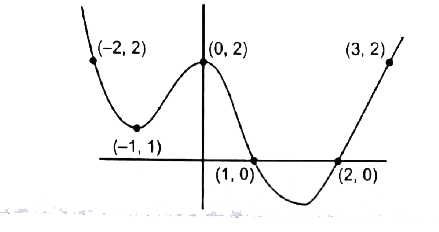In the given figure graph of :
y=p(x)=xn+a1xn−1+a2xn−2+…..+an is given.
![In the given figure graph of : y =p (x) = x ^(n)+a(1) x ^(n-1) +a(2) x ^(n-2)+ …..+ a (n) is given. If p (x) + k=0 has 4 distinct real roots alpha, beta, gamma,delta then[alpha]+[beta]+[gamma]+[delta], (where [.] denotes greatest integer function) is equal to:](https://d10lpgp6xz60nq.cloudfront.net/physics_images/BLJ_VKG_MAT_C04_E03_010_Q01.png)
If p(x)+k=0 has 4 distinct real roots α,β,γ,δ then[α]+[β]+[γ]+[δ], (where [.] denotes greatest integer function) is equal to:
−1
−2
0
1
The correct Answer is:A
Step by step video, text & image solution for In the given figure graph of : y =p (x) = x ^(n)+a_(1) x ^(n-1) +a_(2) x ^(n-2)+ …..+ a _(n) is given. If p (x) + k=0 has 4 distinct real roots alpha, beta, gamma,delta then[alpha]+[beta]+[gamma]+[delta], (where [.] denotes greatest integer function) is equal to: by Maths experts to help you in doubts & scoring excellent marks in Class 12 exams.
Updated on:21/07/2023Topper's Solved these Questions
- APPLICATION OF DERIVATIVES BOOK - VK JAISWALCHAPTER - APPLICATION OF DERIVATIVES EXERCISE - EXERCISE (MATCHING TYPE PROBLEMS)
8 Videos
- APPLICATION OF DERIVATIVES BOOK - VK JAISWALCHAPTER - APPLICATION OF DERIVATIVES EXERCISE - EXERCISE (SUBJECTIVE TYPE PROBLEMS)
22 Videos
- APPLICATION OF DERIVATIVES BOOK - VK JAISWALCHAPTER - APPLICATION OF DERIVATIVES EXERCISE - EXERCISE (ONE OR MORE THAN ANSWER IS/ARE CORRECT )
29 Videos
- AREA UNDER CURVESBOOK - VK JAISWALCHAPTER - AREA UNDER CURVESEXERCISE - EXERCISE (SUBJECTIVE TYPE PROBLEMS)
8 Videos
Similar Questions
Knowledge Check
Let f(x)=(x2−5x+4)(x2+5x+4)andα,β,γ (where α<β<γ) are roots of f'(x)=0, then the value of [α]2+[β+1][γ] is equal to (where [.] denote greatest integer function)
A0B53C52D5If f(x)=ax2+bx+c,a,b,c∈ R and eqation f(x)-x=0 has imaginary roots α,β,γand δ be the roots of f(x) -x=0 then ∣∣ ∣ ∣∣1αδβ0αγβ1∣∣ ∣ ∣∣ is
A0Bpurely realCpurely imaginaryDNone of these
f(x)=x3−9x2+24x+c has real roots α,β,γ then find the value of [α]+[β]+[γ]. Where[] represents greatest integer function
View SolutionTet α,βandγ be the roots of f(x)=x3+x2−5x−1=0. Then [α]+[β]+[γ], where [*] greatest integer function, is equal to
View SolutionIf α,β,γ are roots of x3+x2−5x−1=0 then [α]+[β]+[γ] is equal to
View SolutionIf alpha beta gamma are the roots of x3+x2−5x−1=0 then α+β+γ is equal to
View Solutionsuppose f(x)=3x3−13x2+14x−2.It is assumed that f(x)=0will have three roots say α,β,γ. whereα<β<γthen (1)[α],[β],[γ](where,[.]denotes the greatest function ) willbe in. (2)limn→∞αn!⋅β1n=? (3)tan−1α+tan−1β+tan−1γ=?
View SolutionIf alpha beta gamma are roots of x3+x2−5x−1=0 then α+β+γ
is equal to
View Solution


